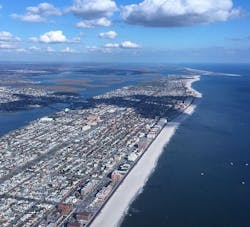Coastal areas of Hempstead lost power for two weeks after Superstorm Sandy. Credit: Christopher Michel
The Town of Hempstead, NY wants to build a microgrid project to ensure power supply for emergency services in two coastal communities that are vulnerable to storms.
The $2.66 million microgrid would provide back-up generation in case of a utility outage in Point Lookout and Lido Beach. Severe coastal storms tend to knock out power to the communities, which were hit particularly hard during Superstorm Sandy, with natural gas out for over a week and electricity for over two weeks.
Located in southwestern Long Island, Hempstead has about 759,757 residents. Twenty-two incorporated villages are entirely or partially within Hempstead. If the town were to be incorporated as a city, it would be the second largest in the state behind New York City and ahead of Buffalo.
The Hempstead microgrid is designed to provide emergency power to critical community facilities including the Point Lookout/Lido Beach Fire Station, the Town’s Water District Well #1 & #2 Main Treatment Plant, and the Town’s Department of Conservation and Waterways Administration.
Of critical importance, the microgrid project would could keep two marinas in operation.The marinas serve as an off-base hub for the Nassau County Police Department and Bay Constables. Powering them with the microgrid could help keep the waterways open for delivery of goods and emergency services when storms close the bridge to the mainland.
The microgrid would combine 24 existing distributed energy resources:
- Five natural gas-fired generators with a combined capacity of 0.561 MW
- Three diesel generators with a combined capacity of 0.5 MW
- Two wind turbines with a combined capacity of 0.102 MW
- 12 photovoltaic (PV) units with a combined capacity of 0.148 MW
- A 60-kW propane generator
- An 8-kW gasoline generator
The plan also proposes adding two additional generators — one diesel and the other natural gas — to cover all storm outage contingencies.
The system is designed to operate autonomously from the main electric grid for one week (7 days x 24 hours/day) using existing and planned fuel storage.
The design also includes 500 kWh of battery storage from ABB, a 125-year-old global supplier of power and grid integration technologies.
The microgrid project is not being designed to sell ancillary services to the grid, but instead is intended solely as an emergency backup system, according to the “Town of Hempstead – NYSERDA NY Prize Community Microgrid Study. The battery storage, therefore, is not intended for end-use consumption. Instead, it will be used to provide frequency modulation for black start.
Read about more community microgrids on Microgrid Knowledge.
Coupled with ABB’s Powerstore, the battery also can help reduce local peak usage. Doing so could lower the demand charges the town now pays to the utility. Demand charges account for about 20 percent of the utility bill for the facilities that will be within the microgrid, according to the study, completed with $100,000 won through the NY Prize.
The community microgrid will employ the ABB Microgrid Plus (M+) controller to maintain overall grid stability and integrate as much renewable energy as possible at any given time. The ABB technology was chosen because it is the only known turnkey system that can disconnect all the facilities in question from the utility grid, balance generation with loads, and re-synch the microgrid with the utility once the grid comes back online, according to the study.
Separately, the Village of Freeport, also located in the town, has proposed its own microgrid to keep power flowing to 46 critical customers which provide fundamental services to the community in the event of a power outage. These include public schools, public housing, medical centers, emergency centers, water/wastewater treatment facilities, banks, gas station, and super markets.
The source of this information is the NY Prize Feasibility Studies, NYSERDA.








